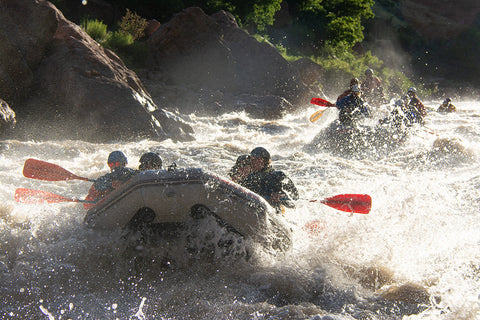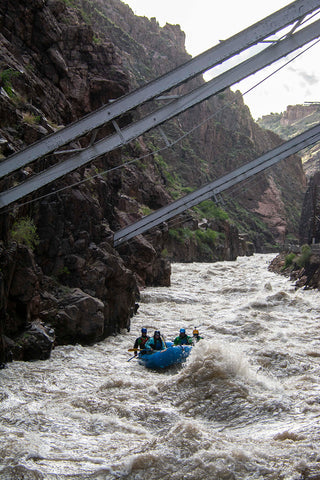There’s nothing quite like running high water. The thrill of taking your boat through huge hydraulic waves is second to none. And we’ve all been dreaming of a season like this, telling our guests and friends, “You gotta come back during run-off; it’s so much fun with more water.”
However, running swollen flows can also be highly stressful. The thought of taking a long, cold swim, or worse, of putting an unsuspecting guest in the water, is enough to keep even seasoned boaters awake at night.
The river has the final word, but there are ways to prepare for high water and better keep yourself and your passengers safe.

1. Rig to Flip, Dress to Swim
This mantra is similar to “Hope for the best, prepare for the worst,” and is never more true than at high water. Be ready for a worst-case scenario by dressing your boat and yourself correctly. For example, you might want to rig a flip line across the bottom of your raft for help getting on top of it.
Likewise, consider rigging OS (Oh! Safety) straps across your thwarts and bringing extra spare paddles. If running an oar frame, ensure all straps are tight and tidy. Clip everything in and lock every carabiner. (Ensure you have no non-locking carabiners anywhere in the boat.)
And, of course, dress to swim. Cold water can make even a short swim more dangerous, and although it may feel like a hot day at the outpost, you need to be prepared. This means wearing a full drysuit or wetsuit and insisting your guests do too.
More importantly, double-check PFDs before you launch. Straps must be snug, almost uncomfortably tight, and keep the PFD from sliding up. If a guest complains, remind them the straps will loosen up once they get wet and start paddling.
2. Start Early
There is little time for correcting, back paddling, or changing course in fast-moving water. You have to set up and start moves as early as possible. But this only works if your crew is responsive and ready to go. So, train your crew!
High water is no time to let your passengers (paying guests or just friends) half-ass their paddle strokes. Practice paddle commands repeatedly, and be upfront if they’re not giving you what you need.
Sometimes guests don’t understand the consequences of high water, and if you have to get assertive or even a little mean to make them listen, great, do it. You are responsible for their safety, not their feelings. Do what it takes to train your crew so you can start moves early and be where you need to be.

3. When in Doubt, Straighten Out
This might seem like basic advice, but it bears repeating: T-up to big features. Plan A might be to avoid the big holes or waves, but sometimes things don’t pan out. If you’re heading toward a big hole or unfriendly hydraulic, hitting it straight (straight backward is good, too) is better than sideways—every time.
In other words, if you’re doubting that you will make it around something, it’s time to straighten out and paddle into it. You’d be surprised what hydraulics you can get through with the right angle and a little momentum.
4. High Water Laps
High-water laps are an excellent way to hone your lines and figure out what goes and what doesn’t. And the best part is they’re so much fun! It shouldn’t be hard to get a crew together after work and run a high-water lap or two. Tell your River Manager it’s for training purposes, and they might even drive your shuttle.
When running high-water laps with experienced paddlers, it’s tempting to try the bigger lines and run the scarier holes. And you should! But don’t forget to practice the lines you’d take with guests. This lets you know when/where to start a move with a less-than-stellar crew.

5. Watch Your Spacing
This probably sounds familiar (maybe redundant), but good spacing is essential during high-flow trips. Closer boat spacing equals shorter swims and faster response times. Stay within a couple of boat lengths of the boats around you.
Along with tight spacing, keep your head on a swivel. Be aware of the boat behind you as much as the boat in front. If something happens, you will be ready to help out before a whistle even blows.
6. Downstream Safety
Setting safety below big rapids is a good way to catch swimmers and save them from a prolonged swim. In some cases, River Rangers take it upon themselves to set downstream safety. You might see them posted up on shore, throw bags at the ready.
In spots where you can’t access shore or rangers aren’t available, set safety from your raft, as you usually would. Let the most experienced guides go first to watch the boats behind them.

7. Practice Self-Rescue
Self-rescue is always important. However, it takes on a whole new meaning during high water. Make sure you can pull yourself into your raft and onto an upside-down raft. (A flip line under your boat is a great tool!)
Practice swimming rapids, breaking eddy fences with your body, and timing your breaths between waves. (Swiftwater Rescue Courses include all of the above, and we highly recommend them for everyone)
When prepping your paddlers for a potential swim, you cannot emphasize self-rescue enough. Be explicit that they can swim to any raft on the river, to shore, or the safety kayaker. Make sure they know that you will be pointing them where to go, and if they see you pointing, they better attempt to move in that direction.
8. Know When to Call It
High water is no joke, and if you have any second thoughts or gut feeling telling you, “This is a bad idea,” it probably is. There is no shame in deciding to portage, end a trip early, or not go at all. Know your limits and your crew's limits and when to move or end a trip.
If your crew is not cut out for high water or you’re uncomfortable, don’t keep it to yourself! In our experience, River Managers and Trip Leaders have your back and would rather you speak up than have an incident. And if a trip gets moved to an easier stretch, make it fun by taking the bigger lines with your guests. Chances are, they won’t know the difference.

9. Practice Throw Bagging
A well-thrown rope can be a life-saver (literally). So, practice throw bagging. All you need is a throw bag (preferably the one you carry on the river). Then practice hitting a target with your rope. Find some friends and practice hitting a moving target.
You can also use a calm, visible stretch of moving water and take turns swimming and rescuing. Don’t forget to practice a variety of tosses, including underhand, overhand, and coil tosses. The more time you spend practicing, the better your chance of getting a rope to someone in need.
Play Another Day!
It’s shaping up to be a record-breaking summer! And you better believe we will be out there chasing peak flow, running the meat, and loving every minute! But we will also do everything possible to stay safe by being prepared, practicing, and making good choices.
What run are you dying to see at high water? Let us know in the comments below, and don’t forget to share this with your crew! SYOTR
By: Megan Y. McPartland





Share:
Stand-Up Paddleboarding: From Flatwater to Waterfalls
Best Rivers to SUP in Colorado.